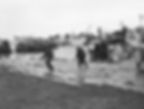What was D-Day? – A Speedy Read for Kids
- Imagining History
- May 30, 2022
- 2 min read
Updated: Mar 27
I know, I know, you’re in a rush! You’ve got things to do, places to be, people to see and, TikTok sea shanties to watch. Modern life can be mighty busy, so, if you want to learn all about D-Day in the speediest of speedy reads, then you’ve come to the right place!

What was D-Day and why was it so important?
D-Day was the name of the operation for the biggest sea invasion in military history. During World War 2, the combined allied forces of the United States, Great Britain, Australia, Canada, Czechoslovakia, Belgium, Netherlands, Poland, New Zealand, Norway, and Greece launched an attack on Nazi-occupied Europe.
This was the first attempt by the Allies to take back Europe from Nazi forces, and would ultimately lead to the liberation of Europe and the end of the Third Reich.
Where was D-Day?
D-Day took place on several beaches along the coastline of Normandy, which is the tippity top bit of France.
What does the D in D-Day stand for?
Confusingly, it doesn’t particularly stand for anything! D-Day is a military term, in fact, many military operations have been dubbed D-Day. The actual name of the invasion was Operation Neptune. Though the conflict was of such historical importance, now when someone refers to D-Day, chances are that they are referring to the events of June 6th, 1944.

June 6th, 1944?
Oh yes, that’s right, I didn’t mention when D-Day took place. In case you’re still unsure, it was on the 6th of June, 1944.
You mentioned it was the biggest sea invasion ever, how big are we talking about here?
Are you ready for some seriously intense statistics? Okay? Here we go:
153,110 Soldiers
10,440 Aircraft (consisting of fighters, bombers, gliders, and transporters)
6,330 Ships (consisting of minesweepers, warships, troops and cargo carriers, destroyers, sloops, and frigates.)
Just imagine seeing that invasion fleet loom over the horizon!

So, what happened on D-Day then?
The vast invasion force crossed the channel from Britain overnight. After significant artillery and air bombardment of the coastal defences, the soldiers disembarked their carriers and attempted to cross the beaches of Normandy at 6.30am.

The heroic Allied soldiers faced significant obstacles in their path, the beaches were mined and covered in barbed wire.
Adding to their misery were the gun emplacements situated on higher ground, which rained down bullets on the invading forces. In total 4,414 brave allied soldiers were killed during D-Day.
Did D-Day succeed?
Not on the first day, no. After 24 hours of hard fighting, the Allies had failed to achieve any of their main objectives. However, they didn’t give up and, on June 12th, the five beachheads were unified. With that, the Allies began the slow march through France. The liberation of Europe had well and truly begun.